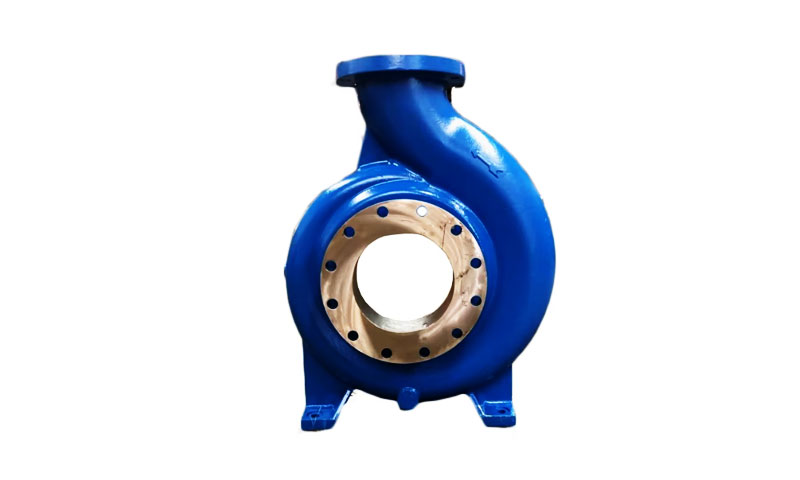1. Ներածություն
Pump bodies are structural and hydraulic housings that convert driver energy into fluid motion. They commonly contain volutes, impeller seats, bearing bosses, flanges and internal passages.
The manufacturing route chosen for a pump body sets achievable geometry, մետալուրգիա, cost and lead time.
Investment casting stands out where geometry is complex (internal guide vanes, thin webs, integrated bosses), tolerances are tight, and high-integrity alloys (Չժանգոտվող պողպատներ, Նիկելի համաձուլվածքներ, բրոնզներ) պահանջվում են.
2. What Is an Investment Casting Pump Body?
Definition and core functionality
Մի շարք Ներդրումների ձուլում pump body is a pump housing produced by the lost-wax (ներդրում) Ձուլման մեթոդ.
A wax (կամ պոլիմեր) pattern of the pump body is created, coated in refractory ceramic to build a shell, the wax removed by heating, and molten metal poured into the ceramic mold.
The fired shell is broken away after solidification to reveal a near-net cast pump body that is subsequently finished and inspected.
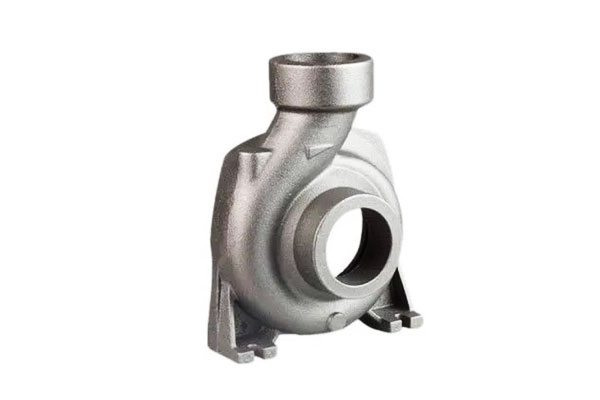
Typical specifications and dimensions
- Part mass: investment cast pump bodies usually range from a few hundred grams to tens of kilograms per piece; many foundries routinely cast pump bodies from ~0.5 kg up to ~50–100 kg depending on plant capability.
- Պատի հաստություն: typical nominal walls for stainless or nickel alloys: 3-12 մմ; minimum thin sections down to 1-2 մմ are achievable in selected alloys and process control.
- Ծավալային հանդուրժողականություն (որպես-դերասան): general investment cast tolerances commonly fall in ± 0,1-0.5 մմ for small features; percent-based tolerance of ±0.25–0.5% linear is a practical rule of thumb.
Critical machined features are usually left with machining allowance (0.2–2.0 mm depending on casting accuracy). - Մակերեւույթի ավարտը (որպես-դերասան): typical Ra 1.6-3.2 մկմ (50-125 րոպե) for standard ceramic shells; fine shells and careful pouring can produce Ra ≈ 0.8–1.6 μm.
Sealing faces or bearing journals are machined/lapped to much finer Ra (≤ 0.2 սուկ) as required.
3. Դիզայնի նկատառումները
Investment casting enables complex geometry, but good design practice maximizes quality and minimizes cost.
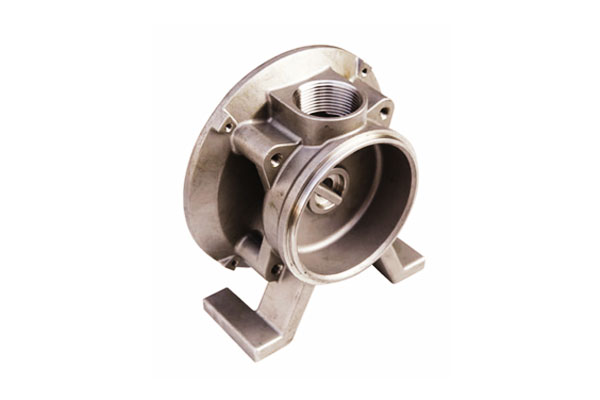
Hydraulic performance requirements
- Flow passages & volutes: smooth fillets and controlled convergence avoid separation and cavitation.
Internal fillet radii should be generous (≥ 1–2× wall thickness) to reduce turbulence. - Impeller seat alignment: concentricity and perpendicularity are critical — plan for machined bores and datum features.
- Clearances: pump clearances at impeller overhangs and seal faces must be maintainable by post-cast machining.
Structural requirements
- Stress & հոգնածություն: consider cyclical loads; use finite-element analysis to identify local stress risers.
Cast metallurgy (Հացահատիկի չափը, անջատում) affects fatigue life—design to avoid thin, highly stressed bosses without proper filleting. - Vibration: stiff webs and ribs help raise natural frequencies; investment casting allows ribs to be integrated into the body.
Կոռոզիիոն & հագնել
- Նյութի ընտրություն: choose alloy based on fluid chemistry (pH, քլորիդներ, Էրոզացիոն մասնիկներ, ջերմաստիճան).
For seawater, duplex or cupronickel may be required; for acids, Hastelloy or appropriate nickel alloys. - Erosion resistance: smooth internal surfaces and sacrificial coatings (շորափող, Mal երմային լակի) are options where particulate slurry is present.
Ծավալային հանդուրժողականություն & Մակերեւույթի ավարտը
- Կրիտիկական հատկություններ: designate which faces/bores are finish-machined and specify machining allowances (օր., 0.5–1.5 mm for sandier shells, 0.2–0.6 mm for precision shells).
- Sealing surfaces: specify Ra and flatness; often lapped/polished to Ra ≤ 0.2 μm and flatness within 0.01-0.05 մմ depending on pressure class.
4. Materials for Investment Casting Pump Bodies
Material selection is a critical factor in designing and producing investment-cast pump bodies, as it directly affects mechanical performance, Կոռոզիոն դիմադրություն, ԱՐՏԱԴՐՈՒՄ, եւ սպասարկման կյանք.
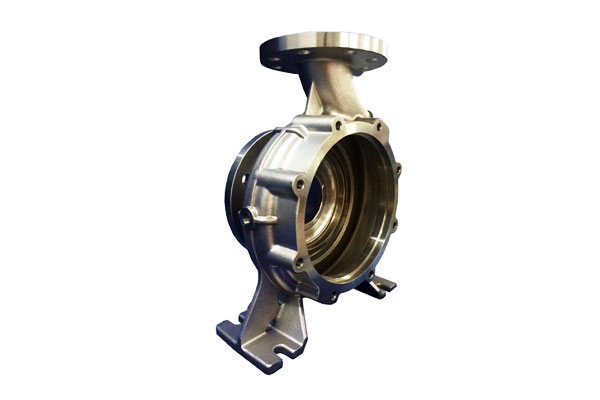
| Նյութի կատեգորիա | Օրինակ համաձուլվածքներ | Հիմնական հատկություններ | Բնորոշ ծրագրեր | ՔԱՂԱՔԱԿԱՆ ԳԻՏԱԺՈՂՈՎ |
| Օստենիտիկ Չժանգոտվող պողպատ | 304, 316Լ | Գերազանց կոռոզիոն դիմադրություն, Չափավոր ուժ, Լավ զոդում; Առաձգական: 480-620 MPA, Զիջել: 170-300 MPA, Երկարացում: 40-60% | General chemical pumps, Treatment րի բուժում, սնունդ & ըմպելիք | Good molten fluidity, low hot-cracking risk, easy post-machining |
| Duplex չժանգոտվող պողպատ | 2205, 2507 | Բարձր ուժ (Yield 450–550 MPa), superior chloride stress corrosion resistance | Marine and offshore pumps, aggressive chemical environments | Requires controlled temperature; post-casting heat treatment to prevent sigma phase |
Նիկելի համաձուլվածքներ |
Ինքնորոշ 625, 718; Հաստելո | Բացառիկ կոռոզիոն դիմադրություն, Բարձր ջերմաստիճանի ուժ, Օքսիդացման դիմադրություն | Քիմիական մշակում, Էլեկտրաէներգիայի սերունդ, յուղել & գազ | High melting points (≈1450–1600 °C); careful mold preheating and controlled pouring needed; difficult machining |
| Բրոնզ and Copper Alloys | C93200, C95400 | Գերազանց ծովային ջրերի կոռոզիոն դիմադրություն, Լավ հագնելու դիմադրություն, antifouling; Ստորին մեխանիկական ուժ | Ծովային պոմպեր, Ծովային ջրերի սառեցում, Հիդրավլիկ բաղադրիչներ | Lower melting points (≈1050–1150 °C) simplify casting; low thermal cracking risk; mechanical strength lower than stainless/nickel |
5. Investment Casting Process for Pump Bodies
Ներդրումների ձուլում, Նաեւ հայտնի է որպես Կորցրած մոմի ձուլում, enables the production of pump bodies with complex geometries, Նիհար պատեր, եւ բարձր ծավալային ճշգրտություն.
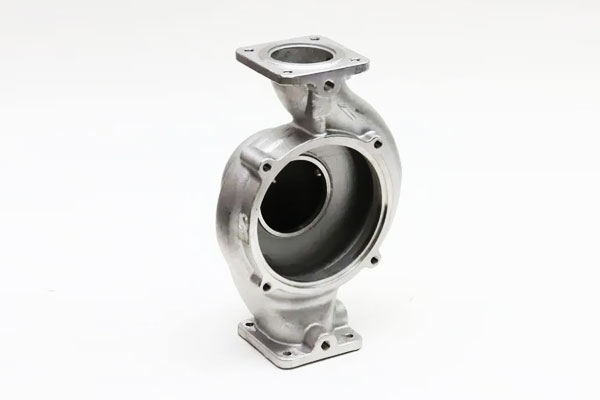
The process consists of several critical steps:
| Քայլ | Նկարագրություն | Հիմնական նկատառումներ |
| 1. Մոմի օրինակների ստեղծում | Molten wax is injected into precision molds to form replicas of the pump body. | Ensure uniform wall thickness; maintain dimensional accuracy ±0.1 mm; use high-quality wax to prevent distortion. |
| 2. Assembly of Wax Tree | Individual wax patterns are attached to a central wax sprue to form a tree for batch casting. | Sprue design affects metal flow; minimize turbulence during pouring. |
| 3. Կերամիկական կեղեւի շենք | Repeated dipping in ceramic slurry and stuccoing with fine refractory sand creates a strong, He երմակայուն կեղեւ. | Target shell thickness (5-10 մմ) depends on pump body size; avoid cracks and porosity in the shell. |
| 4. Dewaxing and Mold Firing | Wax is melted out (autoclave or kiln), խոռոչ թողնելով; the ceramic shell is then fired to remove residues and strengthen the mold. | Temperature ramping must be controlled to prevent shell cracking; residual wax must be fully removed. |
5. Մետաղի թափում |
Հալած մետաղ (Չժանգոտվող պողպատ, nickel alloy, կամ բրոնզ) is poured into the preheated ceramic mold under gravity or vacuum-assisted conditions. | Pouring temperature and rate must ensure complete filling; control turbulence and prevent oxide formation. |
| 6. Կողմում եւ սառեցում | Metal solidifies inside the mold; cooling rates affect microstructure, Մեխանիկական հատկություններ, եւ մնացորդային սթրեսը. | Thick sections may require controlled cooling to prevent porosity; thin walls must avoid hot tearing. |
| 7. Shell հեռացում | Ceramic shell is broken away mechanically, often using vibration, sand blasting, or chemical dissolution. | Avoid damaging intricate pump channels or flanges. |
| 8. Finishing and Cleaning | Residual ceramic, gating system, and surface imperfections are removed via grinding, Կրակոց պայթյուն, or chemical cleaning. | Maintain dimensional tolerances; prepare surfaces for subsequent machining or coating. |
6. Հետծննդաբերական գործառնություններ
After the pump body is removed from the ceramic shell, several post-casting operations are performed to ensure the component meets functional, ծավալային, եւ մակերեւույթի որակի պահանջներ.
These operations are critical for high-performance applications in chemical, ծովային, եւ արդյունաբերական ոլորտներ.
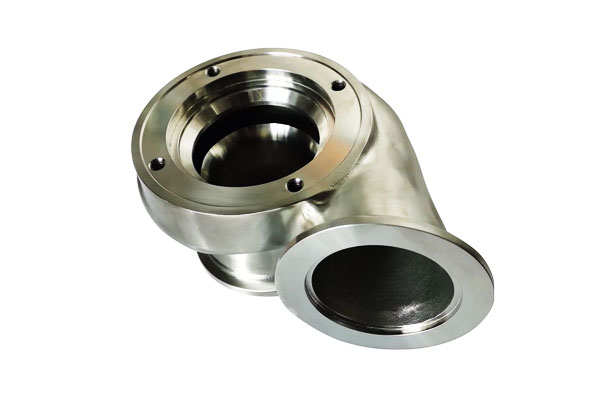
He երմամշակում
He երմամշակում is applied to relieve residual stresses, Բարելավել ճկունությունը, and optimize mechanical properties:
- Սթրեսի ռելիեֆի օծանելիք: Heating to 550–650 °C for stainless steels reduces residual stress from casting and prevents distortion during machining.
- Լուծում Օծողավորում: Applied for stainless steels and nickel alloys to homogenize microstructure and dissolve unwanted precipitates, ensuring corrosion resistance and consistent hardness.
- Aging or Precipitation Hardening (for certain alloys): Enhances strength and wear resistance in high-performance materials.
Վերամբարձ
Critical dimensions such as flanges, իրարանցում, mating surfaces, and threaded ports are machined to meet tight tolerances.
Typical machining operations include turning, ֆրեզերացում, հորատում, and boring. Machining ensures:
- Dimensional tolerances of ±0.05–0.1 mm for precise assembly.
- Smooth sealing surfaces to prevent leaks in high-pressure applications.
Մակերեւութային հարդարման աշխատանքներ
Մակերեւութային հարդարման աշխատանքներ Բարձրացնում է կոռոզիոն դիմադրությունը, Հագուստի դիմադրություն, և գեղագիտություն:
- Փայլեցում: Improves smoothness for sealing faces and internal channels.
- Կրակոց պայթյուն: Removes residual ceramic particles and creates a uniform surface for coating or painting.
- Ծածկույթներ: Optional chemical or electroplated coatings (օր., նիկել, PTFE) enhance corrosion resistance and reduce friction.
Ոչ կործանարար փորձարկում (Նիդ)
To detect defects such as porosity, ճաքեր, կամ ներառումներ, NDT is performed:
- Ռադիոգրաֆիա (Ռենտգեն): Identifies internal voids and inclusions.
- Ուլտրաձայնային փորձարկում (Ut): Detects subsurface flaws in thick sections.
- Ներկերի ներթափանցման փորձարկում (Սուլոց): Reveals surface cracks and porosity.
Cleaning and Inspection
Վերջապես, pump bodies are cleaned to remove residual machining oils, Բեկորներ, or salts. Dimensional and visual inspections verify compliance with specifications before assembly or shipment.
7. Quality Assurance and Testing
Որակի ապահովում (QA) is critical in ensuring that investment casting pump bodies meet design specifications, performance standards, եւ արդյունաբերության պահանջները.
A systematic QA approach combines dimensional checks, Մեխանիկական փորձարկում, and non-destructive evaluation to detect defects and confirm functional integrity.
Ծավալային ստուգում
Dimensional verification ensures that the pump body conforms to design drawings and tolerances:
- Համակարգել չափիչ մեքենաներ (Սամիթ): Measure complex geometries, իրարանցում, եզրեր, and mounting surfaces with accuracy of ±0.01–0.05 mm.
- Gauge Tools: Thread gauges, plug gauges, and height gauges verify critical features quickly in production.
- Մակերեւութային կոշտության չափում: Confirms finishing requirements for sealing faces and internal channels (օր., Ra ≤0.8 μm for hydraulic components).
Mechanical Property Verification
Mechanical testing validates that the material meets required strength, առաձգականություն, եւ կարծրություն:
- Առաձգական փորձարկում: Measures yield strength, Վերջնական առաձգական ուժ, եւ երկարացում, ensuring the material can withstand operational loads.
- Կոշտության ստուգում: Rockwell or Vickers testing confirms that heat treatment and material processing achieved the desired hardness.
- Ազդեցության փորձարկում (Անհրաժեշտության դեպքում): Evaluates toughness for applications exposed to fluctuating loads or shock.
Ոչ կործանարար փորձարկում (Նիդ)
NDT techniques detect hidden defects without damaging the part:
- Ռադիոգրաֆիա (X-ray/CT Scanning): Identifies internal porosity, Ներդրումներ, and voids, particularly in thick sections.
- Ուլտրաձայնային փորձարկում (Ut): Detects internal cracks, ձայն, or delaminations in dense materials like stainless steel and nickel alloys.
- Ներկերի ներթափանցման փորձարկում (Սուլոց): Reveals surface cracks, թիթեղներ, or fine porosity not visible to the naked eye.
- Մագնիսական մասնիկների փորձարկում (Մկան): Applied for ferromagnetic alloys to detect surface and near-surface discontinuities.
Common Casting Defects and Mitigation Strategies
- Ծակոտկենություն: Minimized through proper gating, օդափոխություն, and controlled solidification rates.
- Նեղացման խոռոչներ: Addressed via riser design and thermal management.
- Սառը փակվում է եւ սխալվում է: Avoided by maintaining optimal pouring temperatures and smooth flow in complex geometries.
- Surface Inclusions: Controlled by using high-purity alloys and proper degassing techniques.
8. Advantages of Investment Casting for Pump Bodies
- Համալիր երկրաչափություն: Ներքին հատվածներ, thin walls and integrated bosses with minimal secondary assembly.
- Մոտ զուտ ձեւ: reduces material removal vs. rough machining from bar or billet — often 30–70% less machining for complex parts.
- Բարձր ծավալային ճշգրտություն & Մակերեւույթի ավարտը: less secondary finishing for many features compared with sand casting.
- Alloy flexibility: cast many stainless and nickel alloys with good metallurgical integrity.
- Small to medium production flexibility: tooling for wax patterns is relatively inexpensive vs. large die tooling, enabling economic runs from prototypes to thousands of parts.
9. Սահմանափակումներ եւ մարտահրավերներ
- Cost for very large parts: above certain sizes (հաճախ >100 գդ) investment casting becomes uneconomical compared with sand casting or fabricating/ welding.
- Առաջատար ժամանակը: pattern tooling, shell building and firing add lead time—prototype timelines usually measured in weeks.
- Porosity risk in thick sections: thick bosses or large cross-sections require careful gating, chills or segmenting to avoid shrinkage.
- Surface finish and tolerances depend on shell system: achieving ultra-fine finishes or extremely tight as-cast tolerances requires premium ceramic systems and process control.
10. Արդյունաբերական ծրագրեր
Investment casting pump bodies are used across a broad spectrum of industries due to their complex geometry capabilities, Նյութական բազմակողմանիություն, եւ բարձր ծավալային ճշգրտություն.
The process allows engineers to design optimized hydraulic passages, Նիհար պատեր, and integrated mounting features that improve pump efficiency and longevity.
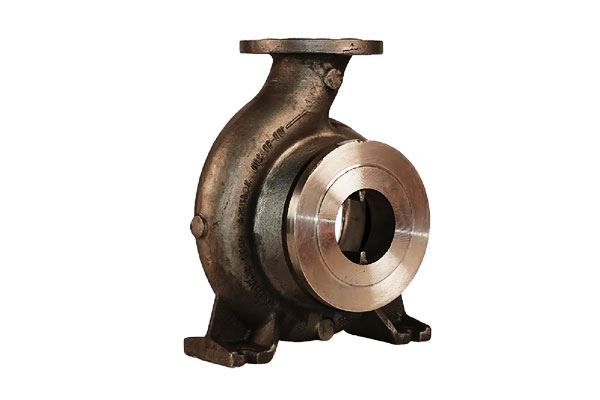
Chemical Processing Pumps
- Միջավայր: Corrosive fluids such as acids, caustics, եւ լուծիչներ.
- Materials Used: Չժանգոտվող պողպատներ (316Լ, կրկնակի) and nickel alloys (Հաստելո, Ինքնորոշ).
- Ռացիոնալ: Investment casting enables intricate internal channels, minimizing turbulence and ensuring uniform flow, critical for chemical process reliability.
Water and Wastewater Pumps
- Միջավայր: High-volume pumping, abrasive suspended solids, and variable pH levels.
- Materials Used: Բրոնզ, Duplex չժանգոտվող պողպատ, and corrosion-resistant cast irons.
- Ռացիոնալ: Thin-wall, smooth internal passages reduce clogging and energy losses, improving efficiency in municipal and industrial water systems.
Marine and Offshore Pumps
- Միջավայր: Saltwater exposure, high-pressure operation, and cyclical mechanical stress.
- Materials Used: Պղնձի խառնուրդներ (Ծովային փողային, բրոնզ), Duplex չժանգոտվող պողպատներ.
- Ռացիոնալ: Resistance to corrosion and biofouling is critical; investment casting allows seamless, complex geometries to reduce maintenance and improve service life.
Յուղել & Gas and Power Generation Pumps
- Միջավայր: Բարձր ջերմաստիճան, high-pressure fluids, and hydrocarbon-based media.
- Materials Used: High-nickel alloys (Ինքնորոշ, Հաստելո), Չժանգոտվող պողպատ, and cobalt-based alloys.
- Ռացիոնալ: Investment casting supports high-strength materials and precise tolerances necessary for critical applications such as turbine lubrication, Քիմիական ներարկում, and offshore drilling.
Specialty and Custom Pumps
- Միջավայր: Laboratory, Դեղագործական, or food processing applications requiring hygienic and precision performance.
- Materials Used: Չժանգոտվող պողպատ (304, 316Լ), տիտղոս, կամ նիկելի համաձուլվածքներ.
- Ռացիոնալ: Հարթ մակերեսներ, Ամուր հանդուրժողականություն, and complex geometries achieved by investment casting ensure minimal contamination risk and compliance with regulatory standards.
11. Համեմատական վերլուծություն
| Հատկորոշում / Չափանիշներ | Ներդրումների ձուլում | Ավազի ձուլում | Machining from Solid |
| Երկրաչափական բարդություն | Excellent – thin walls, Ներքին ալիքներ, intricate features achievable | Moderate – limited by core placement and mold stability | Limited – complex internal geometries often impossible without assembly |
| Ծավալային ճշգրտություն | High – ±0.1–0.25 mm typical | Moderate – ±0.5–1.0 mm | Very High – ±0.05 mm achievable |
| Մակերեւույթի ավարտը (ՀՀ) | Fine – 1.6–3.2 μm typical; can be polished | Rough – 6–12 μm; requires machining for precision | Excellent – 0.8–1.6 μm achievable with finishing |
| Նյութական ընտրանքներ | Wide – stainless steels, Նիկելի համաձուլվածքներ, բրոնզ, Պղնձի խառնուրդներ | Wide – iron, պողպատ, բրոնզ, ալյումին | Wide – depends on machinable stock availability |
| Փաթեթի չափը | Low-to-medium – 1–1000+ parts | Medium-to-high – economical for large, Պարզ մասեր | Low – material waste increases cost for large parts |
| Առաջատար ժամանակը | Moderate – wax pattern & shell building required | Short-to-moderate – mold preparation relatively quick | Variable – depends on machining complexity |
Նյութական թափոններ |
Low – near-net shape reduces scrap | Moderate – gating and risers generate some waste | High – subtractive process creates chips and offcuts |
| Cost per Part | Moderate-to-high – tooling and process steps increase cost, economical for complex parts | Low-to-moderate – simpler molds, larger parts cheaper | High – extensive machining on large, complex parts is expensive |
| Ուժ & Integrity | Excellent – dense microstructure, minimal porosity if controlled | Moderate – risk of sand-related inclusions and porosity | Excellent – homogeneous, Ոչ մի ձուլման թերություն |
| Post-Processing Required | Often minimal – some machining, ավարտ | Usually significant – machining and finishing required | Minimal – final finishing for tight tolerances only |
| Բնորոշ ծրագրեր | Pump bodies with thin walls, complex hydraulic channels, Կոռոզիոն դիմադրություն | Մեծ, simple pump housings or structural components | Custom or prototype pump bodies requiring extreme precision |
12. Եզրափակում
Investment casting pump body combines design freedom with metallurgical integrity, making them an excellent choice for many fluid-handling applications—especially where complex internal geometry, exotic alloys or tight tolerances are required.
Success depends on early design for casting, informed material selection, careful process control (լցնելով, shelling, He երմամշակում), and robust QA/NDT programs.
For critical pump systems—marine, chemical or power generation—investment casting can deliver reliable, economical components when specified and executed correctly.
ՀՏՀ
What maximum size of pump body can be investment cast?
Typical shop practice ranges up to ~50–100 kg per part, but the practical maximum depends on foundry capability and economics.
Very large pump bodies are more often produced by sand casting or fabricating/welding.
How much machining allowance should I design into an investment casting?
Թույլ տալ 0.2-2.0 մմ depending on the criticality and shell precision. Specify tighter allowances only where the foundry guarantees precision shells.
Which material is best for seawater pump bodies?
Duplex stainless steels and selected copper-nickel alloys are common choices due to superior chloride pitting resistance and biofouling performance; final selection depends on temperature, velocity and erosion conditions.
What is the typical turnaround time for an investment-cast pump body?
Small production runs typically take 4-8 շաբաթ from pattern approval to finished parts; single prototypes can be faster with 3D-printed patterns but still require shell firing and melt schedules.
How do I specify acceptance criteria for porosity?
Use industry NDT standards (Ռադիոգրաֆիա, Ցենտ, Ut) and define acceptance levels in percent porosity by volume or via reference images.
Critical pressure-retaining pump bodies often require porosity <0.5% by volume and radiographic acceptance per customer standard.
